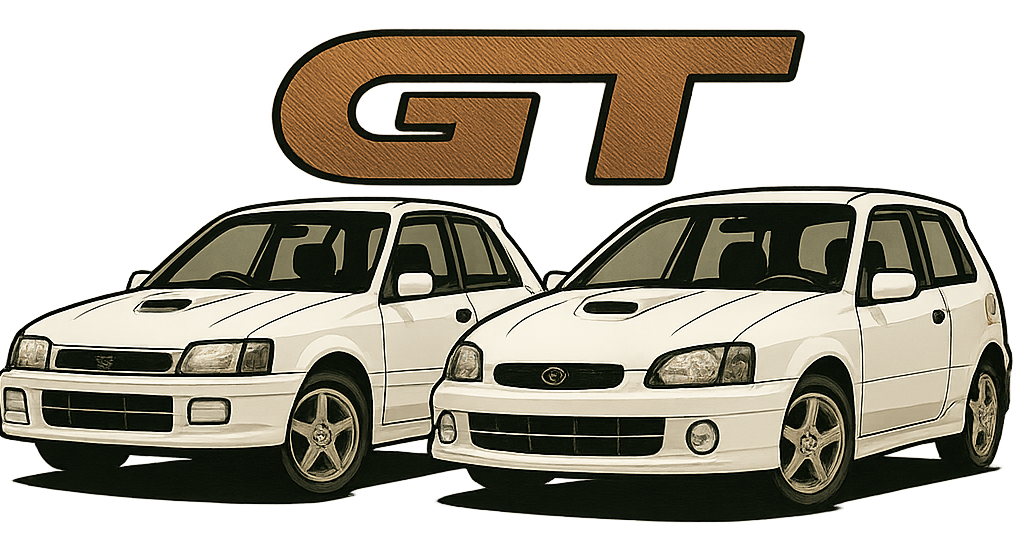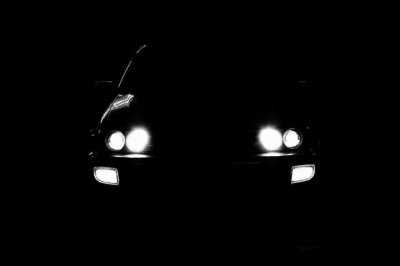Jay
Admin
An Introduction
So how do you research a car that was never officially released in your country? It's usually a very fustrating adventure for most, many rely on word of mouth, a few scattered owners with some experience or an internet search across foreign websites without much in the way of progress.
This is the problem that faced many back in the early days of the Starlet Turbo's escape from Japan. Not anymore however, we can hopefully help shine some light.
The model range
The Starlet GT EP82 started production in December of 1989. It heralded a new era of technology and the spark carried through until December 1995 when the Starlet range was blessed with a fresher chassis.
At this point the Starlet Glanza V EP91 (or 'Flyer' as it became known) increased the safety and visual appeal that the previous model had established. The Glanza carried on the torch until December 1999 when the Starlet model was dropped from the Toyota vehicle range. It was succeeded by the Yaris as Toyota's supermini class offering.
Both the GT and the Glanza V were powered by the 4EFTE 1331cc engine although a few differences were made through the years to increase reliability and performance.
The earlier GT was light, agile and had an incredible 'fun factor' due to it's excellent power to weight ratio. All of this suited the addictive turbo setup and offered an alternative to the other hot hatches available in the Japanese Domestic Market. The Glanza retained the power and reliability of it's older brother but offered a more reinforced bodyshell and modern bodystyling.
All of this was specific to Japan until the vehicles became older and made their way to other countries via the Japanese car auctions.
Under the hood
The main selling point of the Starlet Turbo range is the 4EFTE. This engine is adapted from the naturally aspirated 4EFE and uses the CT9 turbo to produce 135ps of power @ 6,400rpm. This propells the Starlet to 60pmh inside 8.2secs and provides a maximum torque figure of 16.0kg-m @ 4,800.
Worth noting there was an extra blade added to the turbo in the EP91 Glanza V models to help compensate for the additional weight and as such are classed as an upgrade on the GT. Also conrods changed to a lighter design in 1995, the earlier 4EFTE is regarded as stronger due to this. Otherwise the setup remained mostly unchanged for it's production run.
Reliability is a strong part of the script with these engines. Toyota had a policy of over-engineering components and so the durability of the major items is somewhere between good and excellent.
The one thing that is required is maintenance - if the oil system and cooling systems are neglected it can have a drastic effect on the engine and turbocharger. Because the Japanese service history is rarely provided it's essential that cars are inspected and serviced shortly after import and certainly prior to road use.
Be aware that the oil requires renewal every 5,000 kms so it should be reasonably fresh looking. As with any vehicle you should check for signs of oil contamination or leakages from the engine.
The cooling system should be a clear, clean red colour. Coolant that is murky, dark or non-genuine can indicate cooling issues either past, present or future.
Listen for blowouts around the exhaust manifold. It's common for these to crack but remain unseen due to the heat shield. As heat expands the metal it will reduce the noise so it's important to check this when the car is relatively cold.
Let the car warm up and sit at idle for around 5 minutes - a cloud of whitish blue smoke from the exhaust after a short time can indicate a leak in the turbo.
A light tappity noise from the fuel rail area is common on the 4EFTE. It's the idle stabilization valve clicking on the end of the intake manifold.
Check for misfiring under acceleration as ignition components are subject to wear and tear. Damp sparkplugs are a common occurence if the engine bay has been steamwashed.
The crankshaft oil seals can also leak after several years of service. There are two seals, one at each end of the crankshaft. Look at the underside of the engine for any signs of oil from where the gearbox and the engine connect. When replacing this seal it's a recommended procedure to replace the clutch at the same time as it is usually contaminated with oil. The other seal is behind the lower main pulley on the timing belt side of the engine. The belts and pulley have to be removed to replace this. Both seals are labour intensive so budget accordingly.
If you can hear other abnormal or worrying engine noises take them seriously. A new engine can be costly. Err to the side of caution.
Transmission
There were three choices of transmission available when ordering from the factory:
5 speed Manual transmission
5 speed Manual transmission with Limited Slip Differential (LSD)
4 speed Automatic transmission
The standard transmission offers a sound, reliable lifespan. In older or high mileage examples the synchros can wear. Look for selection difficulties and excessive noise during operation to give these away.
LSD gives more stable cornering and extra traction of the line. Worn diffs will usually give audible signs of wear. It's considered a bonus to find a Starlet with this unit fitted although aftermarket LSD's can be retrofitted to the standard gearbox so sometimes an upgraded differential is difficult to confirm from the exterior.
The automatic box is largely ignored as an option. Many consider these as uninvolving to drive and values suffer as a result. Experience with the automatics has taught us that they are much easier to pilot in urban traffic and the performance potential is still there. It's down to personal preference at the end of the day.
One common fault springs to mind with regards to transmission and running gear - CV joints. If a CV boot splits or tears the contained grease can leak out leaving the CV joint exposed to dirt, moisture and contamination. Test the vehicle on full lock (left and right) in a circle and listen for any clicking from the front wheels. This will indicate a worn CV joint. These can be a difficult item to replace so check the boots for leaking grease and listen for clicking when turning.
Suspension
The standard suspension is renowned for being inadequate. This is only true up to a point, remember that all examples are around twenty (yes TWENTY!) years old and therefore suffer from worn shocks and tired springs. A fresh stock setup in good condition is actually quite usable for daily commuting but for more enthusiastic driving it deserves upgrading. Firmer shocks and lowered springs are the cheaper option but coilovers will offer a more involving experience and can be adjusted for personal preference.
Check all rubber suspension bushes, especially top mounts, as they are subject to wear.
Listen for abnormal whirring or vibrations when cornering as wheel bearings can fail.
Steering rack boots usually tear so check along the track rods.
Standard rims were 14" alloys. You may find a rare set of jdm style rims installed instead. Bear in mind missing centre caps or damaged rims may prove hard to source.
The front brake discs do most of the braking. If you feel pulsing or vibrations during braking the discs may be warped. Performance brake items are readily available so it's worth upgrading if you do need to renew them.
Excessive or uneven tyre wear can point to poor geometry and alignment. It can also signal accident damage so be careful.
Interior & Equipment
The interior is conventionally japanese. Made of cheap plastic and with a basic layout it generally takes the miles well. The plastics cope well but expect a few scratches. Some replacement trims can be awkward to find.
It's a considerable bonus to find a Recaro interior as this was a factory option and is an expensive thing to acquire nowadays. Check for worn bolsters and cigarette burns as both are commonplace after so many years of use. The front Recaro seats differ between GT and V but this is simply cosmetic, the style and shape is unchanged.
Worth mentioning that the passenger side tail lamp of mk1 ep82's can let in water but worn boot seals are common throughout all model years so look for any telltale signs of water in the spare wheel well. Another weak point is the seal that the lamps locate into so there's a few things to check.
Airconditioning is standard across the turbo ranges. If it is not blowing cold it's probably overdue a regas. It's common practise to remove the aircon for performance gains so it's worth checking under the bonnet to confirm it's still present.
Window motors can fail if the guides become dry so make sure both operate in a similar fashion and speed.
Bodywork
In general, japanese imports are usually in better condition than their domestic market equivalents. This certainly rings true for the UK where roads are salted in the winter.
At this stage of the game we are seeing increasing cases of rusted out sills. Removing the side trims is not always an option prior to purchase so take a torch and inspect underneath. The rear inner panels can be removed allowing access to the area if you want a reliable method of inspection.
A car can naturally pick up damage during shipping and storage so even on mint freshly imported examples you should check the bodywork over thoroughly.
On older models the upper panels should be examined for lacquer peel. It affects the darker paints more but the Japanese environment can take it's toil on the paintwork of all colours.
Budget for some minor paintwork when buying as bumper scuffs and soft dents are common. With enthusiast-owned vehicles you will find most of these problems have been rectified but less cared for examples will undoubtedly carry more bruises.
Be aware that the quality of imports is sinking as Japan runs out of Starlet Turbos. This means you should be extra fussy and caution should be exercised.
Associated reading:
The EP82 Starlet GT: http://www.toyotagtturbo.com/community/index.php?threads/the-ep82-starlet-gt-model-guide.52/
The Glanza V: http://www.toyotagtturbo.com/community/index.php?threads/the-ep91-glanza-v-model-guide.4249/
Please feel free to ask questions on the forum if you have any, we would be glad to advise best we can!
Last edited:

